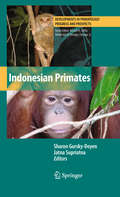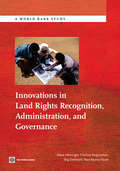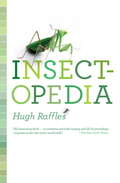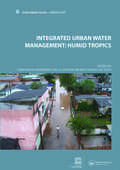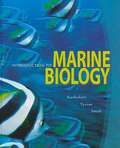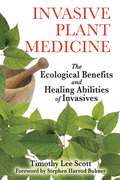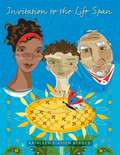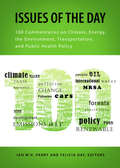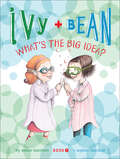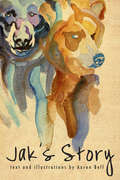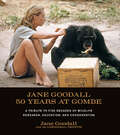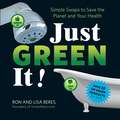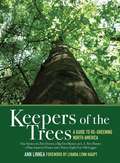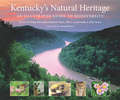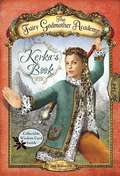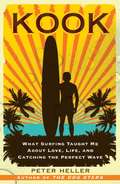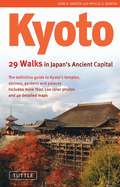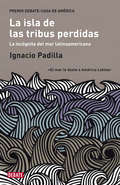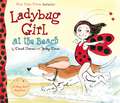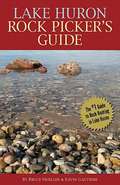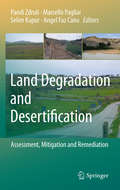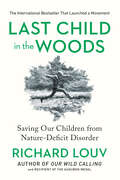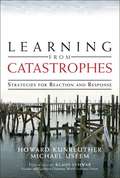- Table View
- List View
Indonesian Primates
by Jatna Supriatna Sharon Gursky-DoyenIndonesia possesses the second largest primate population in the world, with over 33 different primate species. Although Brazil possesses more primate species, Indonesia outranks it in terms of its diversity of primates, ranging from prosimians (slow lorises and tarsiers), to a multitude of Old World Monkey species (macaques, langurs, proboscis moneys) to lesser apes (siamangs, gibbons) and great apes (orangutans). The primates of Indonesia are distributed throughout the archipelago. Partly in response to the number of primates distributed throughout the Indonesian archipelago, Indonesia is classified as the home of two biodiversity hotspots (Wallacea and Sundaland). In order to be classified as a hotspot, an area must have a large proportion of endemic species coupled with a high degree of threat including having lost more than 70% of its original habitat. Two areas within Indonesia meet these criteria. The tremendous diversity of primates in Indonesia, in conjunction with the conservation issues facing the primates of this region, created a need for this volume.
Innovations in Land Rights Recognition, Administration, and Governance
by Paul Munro-Faure Clarissa Augustinus Stig Enemark Klaus DeiningerThe importance of good land governance to strengthen women's land rights, facilitate land-related investment, transfer land to better uses, use it as collateral, and allow effective decentralization through collection of property taxes has long been recognized. The challenges posed by recent global developments, especially urbanization, increased and more volatile food prices, and climate change have raised the profile of land and the need for countries to have appropriate land policies. However, efforts to improve country-level land governance are often frustrated by technical complexities, institutional fragmentation, vested interests, and lack of a shared vision on how to move towards good land governance and measure progress in concrete settings. Recent initiatives have recognized the important challenges this raises and the need for partners to act in a collaborative and coordinated fashion to address them. The breadth and depth of the papers included in this volume, all of which were presented at the World Bank's Annual Conference on Land Policy and Administration, illustrate the benefits from such collaboration. They are indicative not only of the diversity of issues related to land governance but, more importantly, highlight that, even though the topic is complex and politically challenging, there is a wealth of promising new approaches to improving land governance through innovative technologies, country-wide policy dialogue, and legal and administrative reforms. The publication is based on an on-going partnership between the World Bank, the International Federation of Surveyors, the Global Land Tool Network and the United Nations Food and Agriculture Organization provide tools that can help to address land governance in practice and at scale. It is our hope that this volume will be of use to increase awareness of and support to the successful implementation of innovative approaches that can help to not only improve land governance, but also thereby contribute to the well-being of the poorest and the achievement of the Millennium Development Goals.
Insectopedia: Ren Lei Xue Jia Guan Kan Chong Chong De 26 Zhong Fang Shi = Insectopedia
by Hugh RafflesMeditating on our relationship to bugs, Raffles set himself the task of writing an A to Z encyclopedia of a very personal sort, in which he records his thoughts on specific points of insect behavior, strange human behavior involving insects, and human's interests in insects' behaviors based on their own strange predilections. Chinese cricket fights, Himmler's grotesque characterization of Jews as lice, queer sex among insects and animals, and Sahelian locust swarms as another fatal threat in war-ravaged Niger, are among the unlikely and fascinating topics. Annotation ©2010 Book News, Inc. , Portland, OR (booknews. com)
Integrated Urban Water Management: UNESCO-IHP (Urban Water Series)
by Jonathan N Parkinson; Joel A. Goldenfum Carlos E.M.TucciExcess water in the urban environment results in flooding,which causes structural damage, risks to personal safety and disruption to city life. Water is also a major contributory factor for disease transmission as well as being the medium for transport of many pollutants. These problems are of increasing concern due to climate changes and are parti
Introduction to Marine Biology, 3rd edition
by George Karleskint James W. Small Richard TurnerImmerse yourself in INTRODUCTION TO MARINE BIOLOGY and quickly learn the content of the course. While taking an ecological approach, this biology text provides succinct coverage of the content while the photos and art work clearly illustrates key concepts. Studying is made easy with phonetic pronunciations, a running glossary of key terms, end-of-chapter questions, and websites provided at the end of the chapter, and lists of related articles found throughout the text.
Introduction to Water Resources and Environmental Issues
by Karrie Lynn Pennington Thomas V. CechHow much water does the world need to support growing human populations? What factors influence water quality, droughts, floods, and waterborne diseases? What are the potential effects of climate change on the world's water resources? These questions and more are discussed in this thorough introduction to the complex world of water resources. The strength of the book is its coverage of the fundamentals of the science of water, aquatic ecology, geomorphology and hydrology, supplemented by internet resources and examples from water resource issues in the news to engage the student. The book begins with a short history of human use and influence on water, followed by chapters on the geomorphology, hydrology, chemistry, and biology of lakes, rivers, and wetlands. Major disease issues, worldwide water quality and quantity problems, and potential solutions are addressed. Water laws, water allocation, and the conflicts involved are discussed using US and international examples. Students in departments of environmental studies, life science, Earth science, and engineering will benefit from this broad survey of these crucial issues.
Invasive Plant Medicine: The Ecological Benefits and Healing Abilities of Invasives
by Stephen Harrod Buhner Timothy Lee ScottThe first book to demonstrate how plants originally considered harmful to the environment actually restore Earth’s ecosystems and possess powerful healing properties • Explains how invasive plants enhance biodiversity, purify ecosystems, and revitalize the land • Provides a detailed look at the healing properties of 25 of the most common invasive plants Most of the invasive plant species under attack for disruption of local ecosystems in the United States are from Asia, where they play an important role in traditional healing. In opposition to the loud chorus of those clamoring for the eradication of all these plants that, to the casual observer, appear to be a threat to native flora, Timothy Scott shows how these opportunistic plants are restoring health to Earth’s ecosystems. Far less a threat to the environment than the cocktails of toxic pesticides used to control them, these invasive plants perform an essential ecological function that serves to heal both the land on which they grow and the human beings who live upon it. These plants remove toxic residues in the soil, providing detoxification properties that can help heal individuals. Invasive Plant Medicine demonstrates how these “invasives” restore natural balance and biodiversity to the environment and examines the powerful healing properties offered by 25 of the most common invasive plants growing in North America and Europe. Each plant examined includes a detailed description of its physiological actions and uses in traditional healing practices; tips on harvesting, preparation, and dosage; contraindications; and any possible side effects. This is the first book to explore invasive plants not only for their profound medical benefits but also with a deep ecological perspective that reveals how plant intelligence allows them to flourish wherever they grow.
Invitation to the Life Span
by Kathleen Stassen BergerThis brief, original, 15-chapter textbook was created from page 1 to address the challenges teachers and students face when covering the entire life span in a semester (or even a quarter!). The hallmark Berger qualities are all here--the relatable presentation of research, the inclusive approach to world cultures, the study help that builds critical thinking and observational skills, the outstanding media and supplements--and all held together with Berger's skill in bringing students and the science together.
Issues of the Day: 100 Commentaries on Climate, Energy, the Environment, Transportation, and Public Health Policy (RFF Report)
by Felicia Day Ian W.H. ParryIssues of the Day provides an easy way for students, academics, journalists, policymakers, and the public to learn about a diverse range of policy issues affecting the environment, energy, transportation, and public health. Each commentary gives a short assessment of a topic, summarizing in a non-technical way the current state of analysis or evidence on the issue, along with selected recommendations for further reading. The essays are written by world renowned scholars, mostly economists, and provide useful insights on policy problems that are often complex and poorly understood. Some of the topics covered include air pollution, hazardous waste, voluntary environmental programs, domestic (U.S.) and global climate policy design, fishery management, water quality, endangered species, forest fires, oil security, solar power, road and airport, fuel taxes and fuel economy standards, alternative fuel vehicles, health and longevity, smoking, malaria, tuberculosis, and the environment and development. The objective is to disseminate the findings of sound, objective research on the costs, benefits, and appropriate reform of public policies. The book provides a useful supplement for undergraduate- and graduate-level course reading, a reference guide for professionals, and a way for the general reader to quickly develop an informed perspective on the most important policy problems of the day. Issues of the Day is available to download as a PDF from the Resources for the Future website: www.rff.org/weeklycommentary
Ivy and Bean What's the Big Idea? (Ivy + Bean #7)
by Annie Barrows Sophie BlackallIn this seventh entry in the New York Times–bestselling series, two unlikely best friends get creative as they prepare for the Science Fair.It’s the Science Fair, and the second grade is all over it! Some kids are making man-eating robots. Some kids are holding their breath for a very, very long time. Some kids are doing interesting things with vacuum cleaners. The theme, obviously, is global warming. But what should Ivy and Bean do? Something involving explosions? Or ropes? Something with ice cubes? Or maybe . . . maybe something different.Praise for What’s the Big Idea?“This seventh episode about unlikely best friends Ivy and Bean may be the most ambitious and triumphant yet . . . . Barrows and Blackall know just how to expose situations that are familiar to second-graders—with empathy and a light touch.” —Shelf-Awareness
Jak's Story
by Aaron BellThirteen-year-old Jak Loren is a typical boy with the usual problems a family with older sisters and younger brothers presents. Never mind the troubles at school - bullies and girls! When Jak goes to the ravine near his home in Brantford to get away from Steven Burke, a bully who’s been tormenting him, he discovers the ravine has a history that’s much older than he thought. He meets Grandfather Rock, who shares with him the story of the people who have lived near the ravine for thousands of years. Soon Jak’s eyes are opened to a new world of beings and respect. He learns about First Nations people and how their teachings inhabit the spirits of all living things that surround us even today. The tales of the First Nations help Jak to understand that the gift of life is something to be cherished. And when a construction crew arrives in his neighbourhood and threatens his beloved ravine, Jak knows he has to act to save it.
Jane Goodall: A Tribute to the Five Decades of Wildlife Research, Education, and Conservation
by Jane GoodallAn updated, photo-filled account of a half century working with chimpanzees in East Africa by the renowned primatologist.In honor of the field site’s fiftieth anniversary, Jane Goodall: 50 Years at Gombe is a compelling pictorial tribute to Dr. Goodall’s life, her studies of chimpanzee behavior, and her unflagging efforts to motivate people to make this world a better place. With new photographs and updated text throughout, this revised edition retraces five decades of compassion and discovery.Though the book covers a half century, the accomplishments of the past ten years alone have given the Jane Goodall Institute a great deal to celebrate. Recounted are endeavors at the Gombe field site including landmark research related to AIDS progression; establishing programs to improve sanitation, health care, and education in neighboring Tanzanian communities; and partnering with local people to pursue reforestation initiatives.
Keepers of the Trees: A Guide to Re-Greening North America: True Stories of a Tree Doctor, a Big Tree Hunter, an L.A. Tree Planter, a Plant Amnesty Pruner, and a Ninety-Eight-Year-Old Logger
by Lyanda Lynn Haupt Ann LinneaEngage in the life stories of fourteen people whose lives have been shaped by trees-featuring the true stories of a tree doctor, big tree hunter Will Blozan, Plant Amnesty's pruner, and ninety-four-year-old logger Merve Wilkinson. Also interviewed is Vietnam veteran Bud Pearson, whose post-traumatic stress disorder found healing and acceptance as a wood carver in the wilds of Montana, as well as Andy Lipkis, founder of TreePeople, who has spent thirty-five years ripping up concrete in L.A. to plant over two million trees in an effort to stop flooding and reduce air pollution. Each tree keeper reveals the inspiration and organization behind their advocacy with detailed explanations and touching stories of how their lives have come to be shaped by the forests they are fighting to preserve. Keepers of the Trees includes stories from all over North America, including Vancouver, Chicago, L.A., and Montana. This book includes one hundred color photographs of the tree keepers in action as well as diagrams illustrating the keepers' work. These are inspirational stories of conservation, healing, passion, and advocacy for any classroom, conservationist, activist, and nature lover.
Kentucky's Natural Heritage: An Illustrated Guide to Biodiversity
by Deborah White Greg Abernathy Ellis L. Laudermilk Marc Evans“[A] beautiful book about a state that has just about everything except a beach: mountains, swamps, rivers, plains, and, of course, the lovely bluegrass.” —Baton Rouge AdvocateKentucky’s abundance of plant and animal life, from the bottomland swamps in the west to the rich Appalachian forests in the east, is extraordinary as well as beautiful. Glades, prairies, forests, wetlands, rivers, and caves form a biologically diverse patchwork that is unique to the state. Kentucky’s Natural Heritage: An Illustrated Guide to Biodiversity provides an essential reference to the remarkable natural history of the commonwealth and is a rallying call for the conservation of this priceless legacy.Kentucky’s ecosystems teem with diverse native species, some of which are found nowhere else in the world. Kentucky’s Natural Heritage brings these sometimes elusive creatures into close view, from black-throated green warblers to lizard skin liverworts. The aquatic systems of the state are home to rainbow darters, ghost crayfish, salamander mussels, and an impressive array of other species that constitute some of the greatest levels of freshwater diversity on the planet.Richly detailed and lavishly illustrated with more than 250 color photos, maps, and charts, Kentucky’s Natural Heritage is the definitive compendium of the commonwealth’s amazing diversity and presents a persuasive argument for the necessity of conservation. Organized by a team from the Kentucky State Nature Preserves Commission, the book is an outgrowth of the agency’s focus on biodiversity protection.“Between its covers, readers will find details of Kentucky’s vanished natural areas and catalogue of the increasingly rare animal, plants and unique habitats that urgently need protection.” —Louisville Courier Journal
Kerka’s Book (Fairy Godmother Academy #2)
by Jan BozarthFor girls who are fans of Harry Potter and have outgrown the Disney Fairies series and the American Girl books, the Fairy Godmother Academy is the perfect series-fantasy books filled with magic and adventure but grounded by contemporary girls and issues. The series boasts an amazing Web site that allows girls to enter the world they visit in the books. There they can do activities both on- and offline, vote for things they'd like to see in the books, and connect with other Fairy Godmother Academy fans. Zally Guevara always knows where she's going. She has a passion for maps of all kinds and can't wait to pack her suitcase and explore the world. But Zally doesn't have to wait to get her wish. With the help of a cup of magical cocoa from her grandmother, she travels to a place that only girls training to become fairy godmothers can get to-the enchanted dreamland of Aventurine, a place that has no map. In Aventurine, Zally is given her quest: to save a fairy queen who has lost her will to live. Zally's companions are a young fairy with a broken wing, and a stallion prince. The trio's journey proves to be even more challenging than they could have imagined as they meet monsters and get lost in a ruined fairy city. All the while, Zally is making a map of Aventurine and discovering that she has a talent, passed down from generations of women in her family: understanding the thoughts of animals. But will this be enough to save the fairy queen and ensure that Zally can continue her fairy-godmother training? Join the Fairy Godmother Academy! Visit the Web site for games, activities, and networking with friends! www. fairygodmotheracademy. com
Kook: What Surfing Taught Me About Love, Life, and Catching the Perfect Wave
by Peter HellerAuthor of the New York Times bestselling novel The Dog Stars With grit, poetry, and humor, Peter Heller, acclaimed author of The Whale Warriors recounts his remarkable journey of discovery--of surfing, an entirely new challenge; of the ocean's beauty and power; of the strange surf subculture; of love; and, most of all, of how to seek adventure while crafting a meaningful life. Having resolved to master a big-hollow wave-- that is, to go from kook (surfese for beginner) to shredder--in a single year, Heller travels from Southern California down the coast of Mexico in the company of his girlfriend and the eccentric surfers they meet. Exuberant and fearless, Heller explores the technique and science of surfing the secrets of its culture, and the environmental ravages to the stunning coastline he visits. As Heller plumbs the working of his own heart and finds joy in both love and surfing, he affords readers vivid insight into this fascinating world, with all of its perils and pleasures, its absurdity and wonder. Exhilarating, entertaining, and moving, Kook is a love story between a man and his surfboard, a man and his girlfriend, a not-so-old man and the sea.
Kyoto
by John H. Martin Phyllis G. MartinKyoto is Japan's ancient capital and modern-day center of tourism and traditional culture. Founded nearly 1,300 years ago and undamaged by the war, Kyoto today is one of the world's most beautiful and historic cities, home to 17 World Heritage sites and over 2,000 temples and shrines.Kyoto presents 29 easy-to-follow walking tours through the city's 1,300 years of history, its many unique districts and scenic areas full of charm and character. This updated, greatly expanded guide features over 100 color photos, as well as approximately 40 brand new, full-color guide maps and diagrams of individual sites.
La isla de las tribus perdidas
by Ignacio Padilla«Un mundo abrumado por su propia naturaleza, visto a través de las metáforas del agua, surge ante nosotros en este ensayo deslumbrante que recorre la tradición literaria de todo un continente», así justificaba su fallo el jurado del III Premio Iberoamericano de Ensayo Debate-Casa de América. En efecto, La isla de las tribus perdidas es una elegante narración que sigue la estela de Ulises y retoma los motivos clásicos del naufragio, la tempestad, el barco o la isla, para contar cómo Latinoamérica se convierte sin quererlo en el reverso de Occidente. Una bella inmersión en las fuentes literarias americanas donde Gabriel García Márquez, Julio Cortázar, Jorge Luis Borges, Carlos Fuentes, Juan Carlos Onetti o Alejo Carpentier son las aguas en que se refleja la relación conflictiva de un continente con el mar, pues tanto le duele el mar a América Latina que decidió vivir de espaldas a él.
Ladybug Girl at the Beach (Ladybug Girl)
by Jacky DavisIt is preschooler Lulu’s first time at the beach and she needs to conquer her fear of the ocean in this hardcover picture book from the New York Times bestselling Ladybug Girl series. Lulu has never been to the beach but she knows she is going to love it…until she sees just how big and loud the ocean is. She and her dog Bingo decide that they will make sandcastles, fly kites, and get ice cream instead of swimming. But then the ocean waves snatch Lulu’s favorite pail. This is a job for Ladybug Girl! When Lulu is Ladybug Girl, she is brave and nothing can stop her from rescuing her pail – and suddenly she is in the ocean and it is fun! This story is the perfect preparation for a first beach vacation, or to explore a new experience with a preschooler. Mama and Papa are never far away while Ladybug Girl builds up her courage and confronts something scary for the first time. For fans of Fancy Nancy and Angelina Ballerina, the Ladybug Girl series honors courage, creativity, and a love of nature!
Lake Huron Rock Picker's Guide
by Bruce Mueller Kevin GauthierBruce Mueller is owner of the C&M Rock Shop in Honor, Michigan. He holds a master's degree in geology from the University of Illinois. He is also the author of The Complete Guide to Petoskey Stones. Kevin Gauthier is a business graduate from Michigan State University and has completed courses through Gem Institute of America (GIA). He has spent a lifetime collecting, cutting, and polishing the gems found around Lake Huron. Kevin is co-author with Bruce Mueller of Lake Michigan Rock Picker's Guide and Lake Superior Rock Picker's Guide. He is owner of Korner Gem in Traverse City, Michigan: www. kornergem.com.
Land Degradation and Desertification: Assessment, Mitigation and Remediation
by Selim Kapur Angel Faz Cano Marcello Pagliai Pandi ZdruliLand Degradation and Desertification: Assessment, Mitigation, and Remediation reports research results in sustainable land management and land degradation status and mitigation in 36 countries around the world. It includes background papers with continental and international perspectives dealing with land degradation and desertification studies. The book assembles various topics of interest for a large audience. They include carbon sequestration and stocks, modern techniques to trace the trends of land degradation, traditional and modern approaches of resource-base conservation, soil fertility management, reforestation, rangeland rehabilitation, land use planning, GIS techniques in desertification risk cartography, participatory ecosystem management, policy analyses and possible plans for action. Various climatic domains in Africa, Asia, Europe and The Americas are covered. The book will be of interest to a variety of environmental scientists, agronomists, national and international policy makers and a number of organizations dealing with sustainable management of natural resources.
Last Child in the Woods: Saving Our Children From Nature-Deficit Disorder
by Richard Louv“The children and nature movement is fueled by this fundamental idea: the child in nature is an endangered species, and the health of children and the health of the Earth are inseparable.” —Richard Louv, from the new edition In his landmark work Last Child in the Woods, Richard Louv brought together cutting-edge studies that pointed to direct exposure to nature as essential for a child’s healthy physical and emotional development. Now this new edition updates the growing body of evidence linking the lack of nature in children’s lives and the rise in obesity, attention disorders, and depression. Louv’s message has galvanized an international back-to-nature campaign to “Leave No Child Inside.” His book will change the way you think about our future and the future of our children. “[The] national movement to ‘leave no child inside’ . . . has been the focus of Capitol Hill hearings, state legislative action, grass-roots projects, a U.S. Forest Service initiative to get more children into the woods and a national effort to promote a ‘green hour’ in each day. . . . The increased activism has been partly inspired by a best-selling book, Last Child in the Woods, and its author, Richard Louv.” —The Washington Post “Last Child in the Woods, which describes a generation so plugged into electronic diversions that it has lost its connection to the natural world, is helping drive a movement quickly flourishing across the nation.” —The Nation’s Health “This book is an absolute must-read for parents.” —The Boston Globe Now includesA Field Guide with 100 Practical Actions We Can Take Discussion Points for Book Groups, Classrooms, and Communities Additional Notes by the Author New and Updated Research from the U.S. and Abroad
Le Japon Artistique: Japanese Floral Pattern Design in the Art Nouveau Era
by Museum of Fine Arts, BostonEnchanting floral imagery from Boston&’s Museum of Fine Arts to inspire anyone who loves art and design. Celebrating an era of dynamic and creative cross-pollination between Japanese design and European Art Nouveau at the turn of the last century, Le Japon Artistique features stunning floral imagery drawn from a variety of rare books held in the collection of the Museum of Fine Arts, Boston. Seldom seen outside the museum context, these lush botanical motifs are as visually enchanting as they are significant in the arc of Japanese art history—and this volume serves as both a reference for artists and a treat for art and design lovers in springtime or any season.
Learning from Catastrophes: Strategies for Reaction and Response
by Michael Useem Howard KunreutherBreakthrough, business-focused techniques for managing the growing risks of catastrophe, from world's leading experts--Indispensable 'extreme risks' guidance for decision-makers in a world that is becoming increasingly unstable. -Powerful assessment models, decision-making techniques, and best practices for building resilience into any organization, public or private. -Edited by the leading experts who recently introduced influential new techniques for managing extreme risks at the World Economic Forum. Events ranging from Hurricane Katrina to the global economic crisis have taught businesspeople an unforgettable lesson: if you don't plan for 'extreme risk,' you endanger your organization's very survival. But how can you plan for events that go far beyond anything that occurs in normal day-to-day business? In Learning from Catastrophes, two renowned experts present the first comprehensive strategic framework for assessing, responding to, and managing extreme risk. Howard Kunreuther and Michael Useem build on their own breakthrough work on mitigating natural disasters, extending it to the challenges faced by real-world enterprises. Along with the contributions of leading experts in risk management, heuristics, and disaster recovery, they identify the behavioral biases and faulty heuristics that mislead decision makers about the likelihood of catastrophe. They go on to identify the hidden links associated with extreme risks, and present techniques for systematically building greater resilience into the organization. The global best-seller The Black Swan told executives that 'once in a lifetime' events are far more common and dangerous than they ever realized. Learning from Catastrophe shows them exactly what to do about it.
